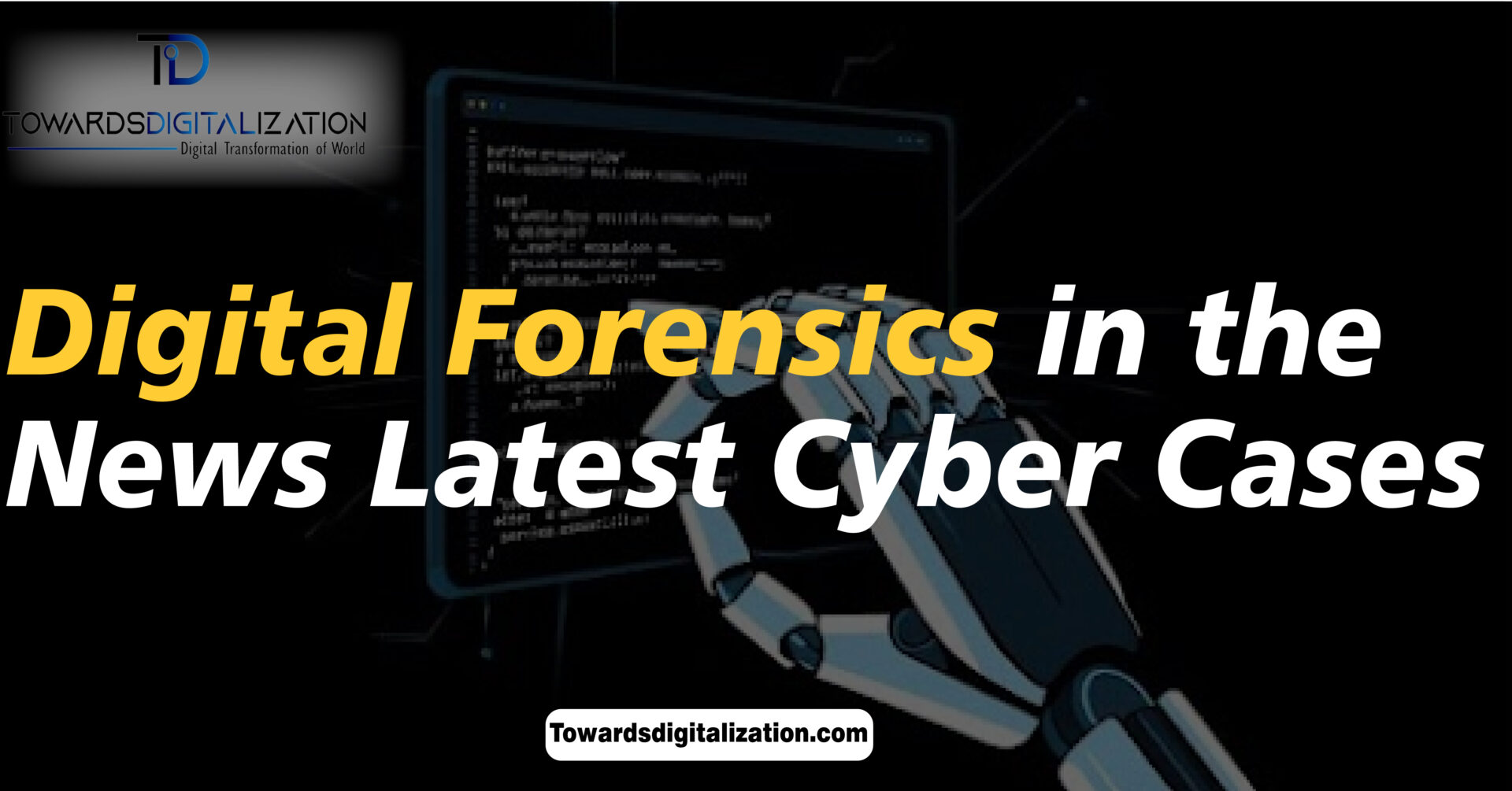Introduction
Digital Forensics in Modern Crime Scenes: Cybercrime has become an everyday reality in our digitally connected society. Digital Forensics Is Now an Essential Part of Criminal Investigation. Cyberspace is now the target for illegal activities ranging from data breaches and corporate espionage, through threats to national security, and more serious cybercrime attacks that require urgent forensic response. Due to this threat, digital forensics is now integral in criminal investigations worldwide. Digital Forensics involves collecting, preserving, analysing, and presenting evidence gathered from computers, networks, or any internet-based platforms.

As cyber crimes become an ever-increasing global problem, the importance of digital forensics for identifying perpetrators and solving such crimes cannot be stressed enough.
Understanding Digital Forensics: Scope and Importance
Digital forensics encompasses various branches such as computer forensics, mobile device forensics and cloud forensics. The main goal is locating, authenticating and analysing digital data used for civil, criminal and corporate investigation this discipline being employed by law enforcement or intelligence agencies or corporate investigators to locate illicit activities as well as recreate digital incidents.
Digital Forensics Have Evolved As Cyber crime Has Proliferated Digital forensic has evolved as an essential tool for both private and law enforcement organisations alike as a result of cyber crime, becoming more than simply recovering lost files but instead creating timelines, identifying dangers, and producing digital evidence to be presented at trial.
Identification:
Recognising digital evidence.Preservation involves creating forensically sound copies of to protect and secure its integrity.
Analyse:
Examining digital information using tools designed to extract and interpret it. Documenting Documenting process and results into an easily accessible report.
Presentation:
Provide evidence effectively within corporate or legal environments.Electronic evidence can easily be altered or lost, thus necessitating professional forensic services ensuring their chain custody remains disrupted and every process follows legal standards.
Cyber Attack (2021-2022)
One of the most sophisticated cyber attacks to date was the Solar Winds breach which compromised over 18,000 companies and U.S. federal agencies. Digital Forensic teams played an instrumental role in identifying backdoor malware (SUNBURST), as well as pinpointing its scope and source; analysts then employed endpoint and network forensics analysis techniques to detect any intrusion attempts and begin remediation measures immediately after discovery of intrusion attempts.
Colonial Pipeline Ransomware Attack (2021)
As ransomware caused havoc across the East Coast of the US, Digital Forensic Analysts quickly intervened by retrieving logs, identifying Dark Side ransomware variant and helping find small amount through blockchain analysis showing just how digital forensic can provide crucial evidence of cyber crime related transactions. This particular instance highlighted digital forensic unique capability of tracking crypt transactions linked to cyber criminal activities.
Pegasus Spyware Scandal (2021)
The Pegasus malware incident raised global concerns regarding surveillance. Digital Forensic experts from Amnesty International and Citizen Lab investigated affected phones to discover signs of Pegasus. their reports then served as crucial evidence in international probes into this malware’s activities.
FTK (Forensic Toolkit):
One of the more well known software applications designed to process data and display.
Autopsy:
A free of cost platform used for digital investigation.
Wire shark:
Used for monitoring network traffic.Volatility provides a framework for memory forensics by extracting RAM contents.X-Ways Forensics stands out for its fast and comprehensive reporting features.Investigators need a way to examine devices without altering any original data, which is paramount in maintaining evidence integrity. This technology helps investigators do just that.
Legal and Ethical Implications of Digital Forensics
Digital forensic practices must comply with international and national data privacy regulations such as GDPR and HIPAA, while there can also be ethical challenges when investigating accessing private devices or encrypted information. the balance between gather.

Documenting chain of custody, warrants and compliance with legal protocols are crucial components to the admissibility of evidence in court. Any improper use of digital forensic methods and instruments could carry severe legal implications including dismissal of cases or accusations of evidence tampering.
Digital Forensics in Law Enforcement and Government Agencies
Police forces across the world employ digital forensics teams within their investigations of crimes from identity theft to cyberstalking to terrorist acts and human trafficking.
Authorities such as the FBI, NSA and Interpol utilize digital forensics not just for criminal cases but also as part of national security; for example they utilize it for monitoring terror groups, cyberspace attacks as well as efforts against radicalization online.
Notable examples include the FBI’s use of forensic instruments to decry pt an iPhone used in 2015 San Bernardo terrorist attack and cause confusion and concern regarding encryption and privacy issues.
Corporate and Private Sector Applications of Digital Forensics
Companies often utilise digital forensics technology in conducting internal investigations, including:
Authoritative misconduct from employees
Digital Forensic Following any data breach, digital forensic help companies uncover its source and what was lost through an attack, along with ways to stop such incidents from recurring again.The When Equinox was compromised in 2017 affecting over 147 million lives and their data, their digital forensic analysts identified both its security flaw and date of occurrence using digital forensic analysis.
Digital Forensic Experts Can Face Difficulties
While effective digital forensic poses several unique obstacles and issues, its implementation remains fraught with obstacles and hurdles. Shortfalls:
Tools of Security and Privacy:
Tools like Tor, VPNs and end-to-end encryption make identifying perpetrators harder than ever before.
Investigators must sort through vast quantities of information in order to locate evidence relevant to their investigation.
Cloud and Devices:
The distributed nature of data storage can make investigations difficult, leading to more time being required to gather relevant evidence.
Rapid Tech Development:
Investigators must regularly upgrade their knowledge and equipment in order to remain compliant with rapidly advancing technological trends.
Questions Regarding Cross Jurisdictional Disputes:
Crimes that span several countries create both legal and procedural complications that must be navigated successfully.To address these challenges, instruction, international collaboration and legal reform must continue to play an essential part.Artificial Intelligence and Big Data evolution The combination of artificial intelligence with big data analytics in digital forensic is revolutionising this field. Automated Log Analysis to detect anomalous network behavior. Reduce timeline construction time.
Discover hidden relationships among digital entities
Big data platforms enable forensic experts to manage large datasets more effectively, using AI-powered software for such things as detecting deepfakes or ransomware variations as well as performing sentiment analyses of cyber bullying incidents.
While this exposure might bring greater understanding to this branch of investigation science for some consumers it might also create misconceptions as to its operation speed or ease.
Digital Forensics can be an intricate and lengthy process. Public understanding of its processes and limitations will aid legal decisions made with digital evidence as the basis.
Future of Digital Forensics: What Lies Ahead
Technology has become more integrated into everyday life and digital forensic will only become increasingly important over time. Trends which will shape its growth include.
Cloud native forensic tools
Blockchain provides an unutterable record to secure evidence.Post quantum Cryptography Challenges.AI can assist with digital detection of crime.Future developments will feature tighter regulation, international data sharing agreements and greater focus on ethics when applied to forensic situations.
Conclusion: An Essential Discipline in a Digital World
Digital Forensics have become an indispensable aspect of cyber crime investigation and resolution, from solving high-profile crimes to protecting national infrastructure as well as corporate secrets. its applications range far and wide and play an invaluable role. With every day that passes by online, more high-skilled forensic professionals along with cutting edge technology and ethically sound policies become ever more crucial in combating this crime.
Frequently Asked Question
Question 1. What Is Digital Forensics, and Why is It So Crucial?
As such it plays an essential part in investigations against cyber criminal acts while protecting evidence integrity thereby supporting legal proceedings more easily than other investigative methods can.
Question 2. What Role Can Digital Forensics Play in Addressing Cyber crime?
The process of digital forensics helps security and law enforcement agencies detect cyber attacks by finding malicious software, recovering deleted files and studying any non-approved access patterns. It provides crucial intelligence in terms of both perpetrator identification as well as future preventive attacks against their networks.
Question 3. What are some noteworthy cases where digital forensics were utilized?
Examples include Solar Winds cyber attack, Colonial Pipeline ransomware incident and Pegasus spyware revelations where digital forensics provided important insight to assist investigators and increase public comprehension of these events.
Question 4. What Tools Are Most Frequently Employed to Conduct Digital Forensic?
Investigations desolateness forensic investigations. The tools most frequently utilized include EnCase, FTK, Autopsy Volatility and Wireshark which enable experts in digital forensics to collect, analyse and present evidence in an orderly and legally compliant fashion.
Question 5. Can digital forensic evidence be utilized in court?
Absolutely if handled appropriately; evidence obtained through digital sources is admissible as part of any trial proceeding. Investigators must maintain an effective chain-of-custody. Arrangement and follow guidelines designed to verify validity and reliability in evidence presented at court hearings.
Question 6. What challenges do digital forensics professionals currently face?
The main issues for digital forensics specialists today include data encryption. Large volumes of digital information and jurisdictional complexities related to cross-border crime as well as rapid. Technological change and investigations of cloud or environments.
Question 7. What ways are police departments using digital forensics?
Both police and federal departments utilize digital forensics in investigating cyber terrorism. The fraud or identity theft and sexual harassment committed through cyberspace. They collect evidence from devices like phones or servers so as to prosecute criminals more easily.
Question 8. Is Digital Forensics Used in Private Industry?
Yes. Companies employ digital forensics in order to detect internal. The corruption as well as violations against information policies. intellectual property theft or employee misconduct within their organisations, which assists with monitoring compliance and mitigating risks to reduce potential liabilities for the firm.
Question 9. What ethical and legal issues arise with Digital Forensics?
The legal issues include privacy rights, accessing devices under warrant. The obtaining warrants to do so and complying with relevant privacy legislation (like GDPR ). However, forensic experts must refrain from altering data, respect individuals rights while remaining impartial when conducting analysis.
Question 10. What role can artificial intelligence (AI) play in modern digital Forensics?
AI helps improve digital forensics through automating large-scale analysis and pattern identification within cyber attacks; as well as speeding up investigative workflows by quickly finding irregularities within cyber attacks. The speeding up investigative workflows – especially helpful when managing large data systems and cybersecurity threat intelligence.








